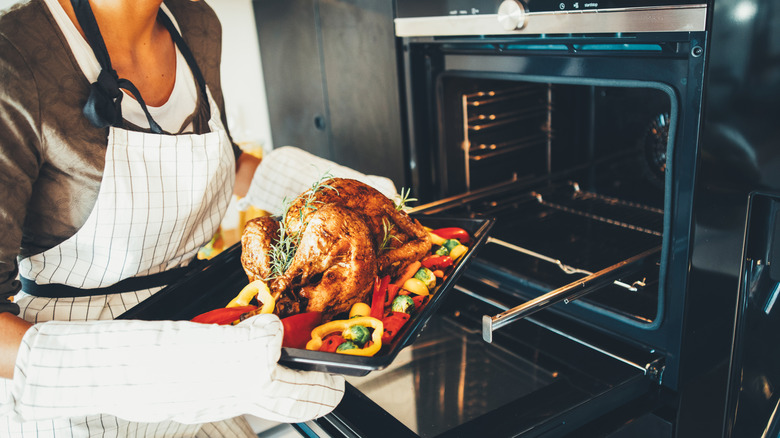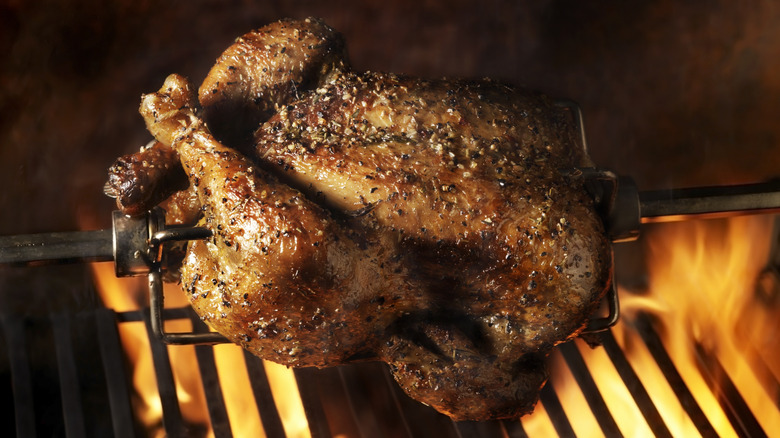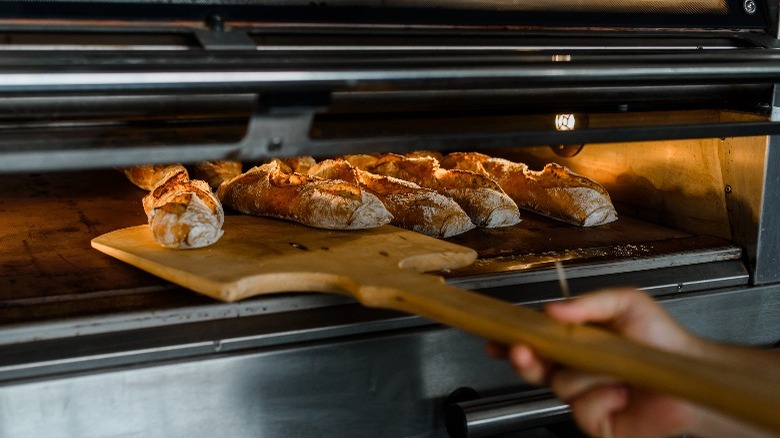What It Means To Bake Vs. Roast Food In The Oven
Good news for aspiring chefs: Although the culinary world has a seemingly unending list of different methods of cooking, baking and roasting are essentially the same thing. From broiling to poaching to grilling to smoking, there is a multitude of terms to memorize. However, two of the most commonly repeated cooking methods — baking and roasting — are so similar to each other that you can essentially summarize them both as "heating food up in the oven." The key difference is merely a change in temperature.
While baking usually refers to a medium heat of around 375 to 400 degrees Fahrenheit, roasting denotes a higher heat above 400 degrees Fahrenheit. The nomenclature is more of a descriptor of the way the ingredients put inside the oven turn out as a meal. Recipes will use the term "roast" when talking about a solid piece of meat or vegetable, such as roast chicken, roasted peppers, or simply a (holiday) roast. "Baking," on the other hand, usually means that a less-formed concoction will come out of the oven as a more solid dish. Think of baking a pie or cake that starts off as dough or batter. Of course, there are exceptions to this terminology, like in the case of something like "baked fish," but that's because the differences between definitions are flexible.
Why use different words anyway, then?
Both baking and roasting are dry heat cooking methods, but the reason for the difference in nomenclature probably has to do with their usage before the invention of modern ovens. Before cast iron stoves became commonplace in households, home chefs cooked meats in their hearths over open fires or in Dutch ovens. The easiest method of preparation was stewing or boiling a meal in a pot held over a flame, meaning that wet cooking was the preferred type of preparation before the advent of stoves in the mid-eighteenth century. Roasting, which referred to turning meat with a skewer or spit held over hot coals, was a trickier affair since someone had to closely monitor the food to make sure there was frequent rotation.
On the other hand, "baking" was a term typically used when talking about placing a loaf of bread in a clay or brick oven, as opposed to roasting dishes over an open fire. Once coal ovens were available to a wider market, however, it became possible to likewise roast meals inside of an enclosed space. As food historian Roger Horowitz explains while citing an eighteenth-century cookbook, "kitchens were no longer 'equipped for roasting meat,'" thus "baking 'has come to be called roasting.'"
What about convection roast?
Some modern ovens don't even include separate roast or bake options, instead just presenting a temperature control option since anything above 400 degrees Fahrenheit is considered roasting, anyway. However, some ovens include a convection roast or bake option, which means that there's a fan that can circulate air around the food in a way that's almost identical to an air fryer.
Since this hearkens back to spinning a piece of meat over an open fire, convection roasting may just be the best default option for any sort of recipe that calls for roasting. The moving air will more deeply caramelize the oven's contents, meaning that your roasts will come out crispier. However, take more caution when choosing whether to use the convection bake option. This works well for cookies, pies, and pastries for an even crisp and additional steaminess, but stay away from convection baking bread or cake since it can dry out these goodies.



